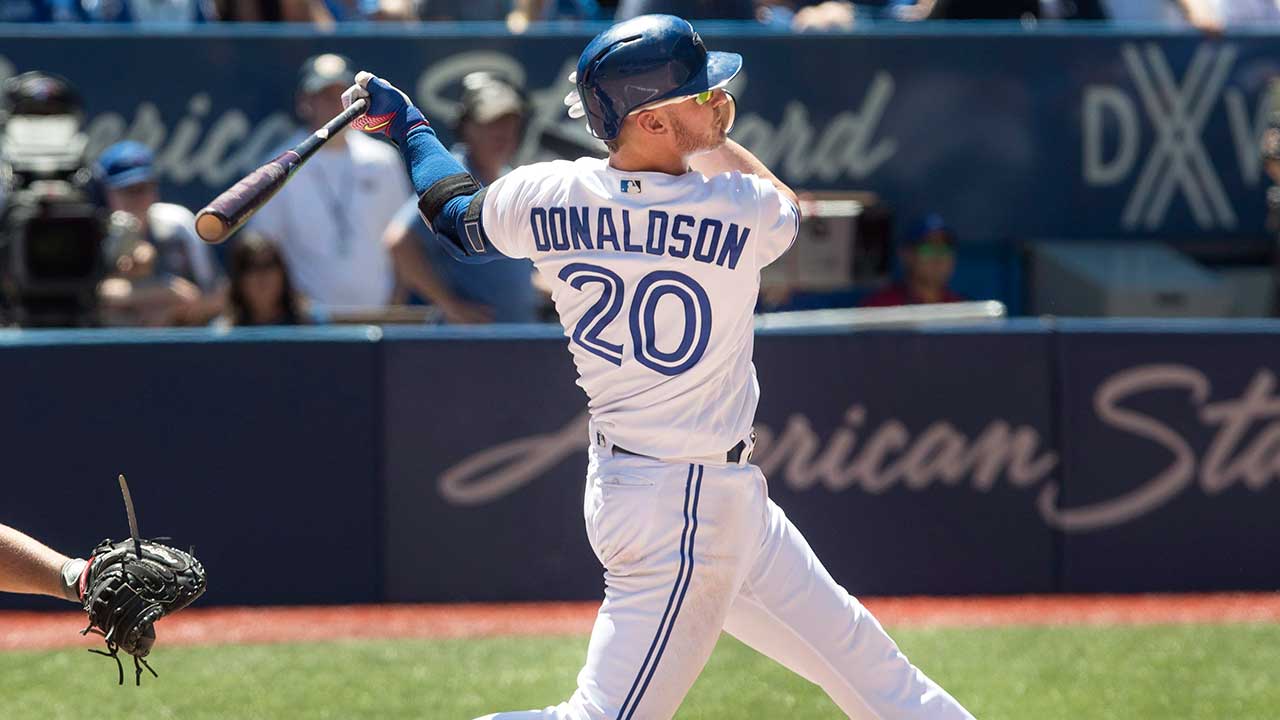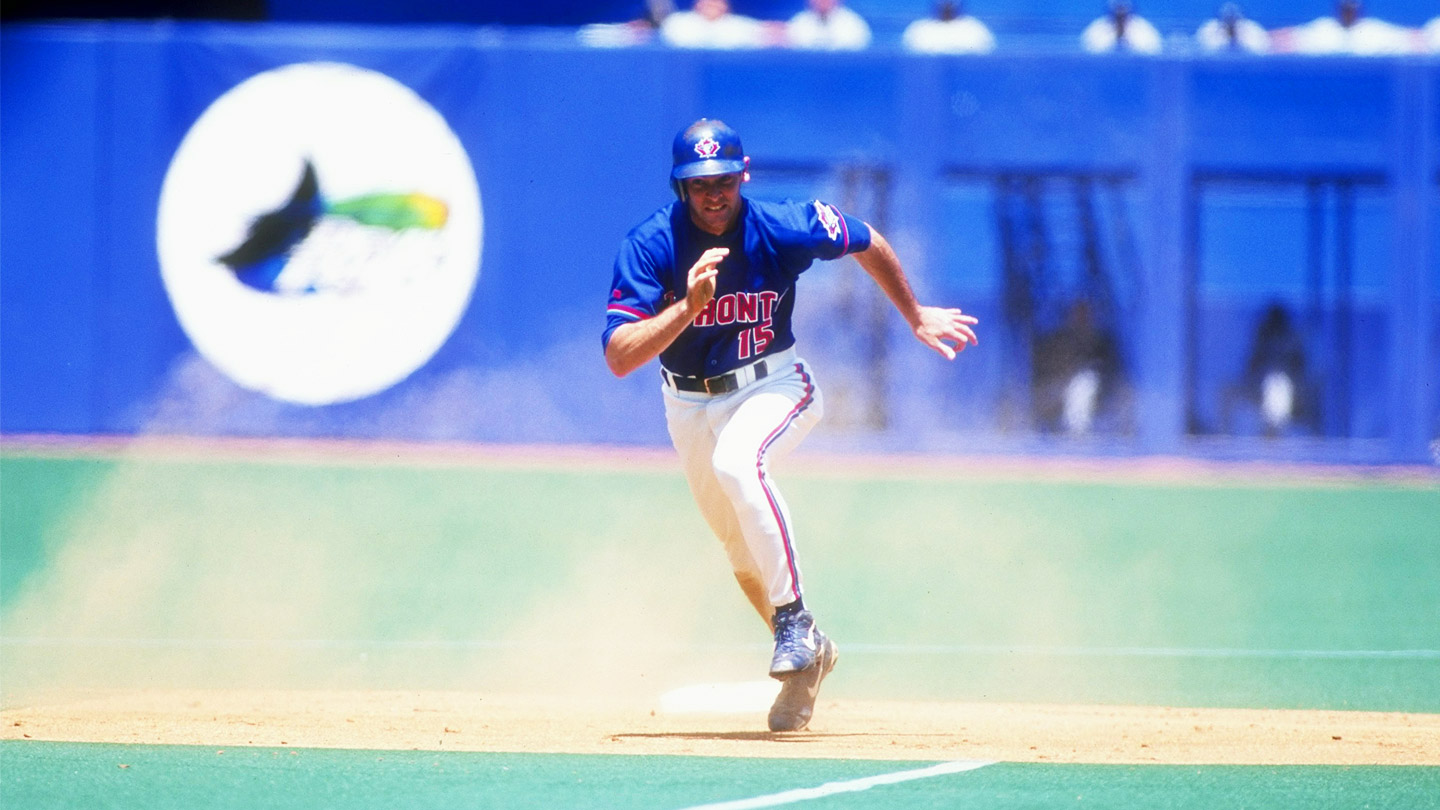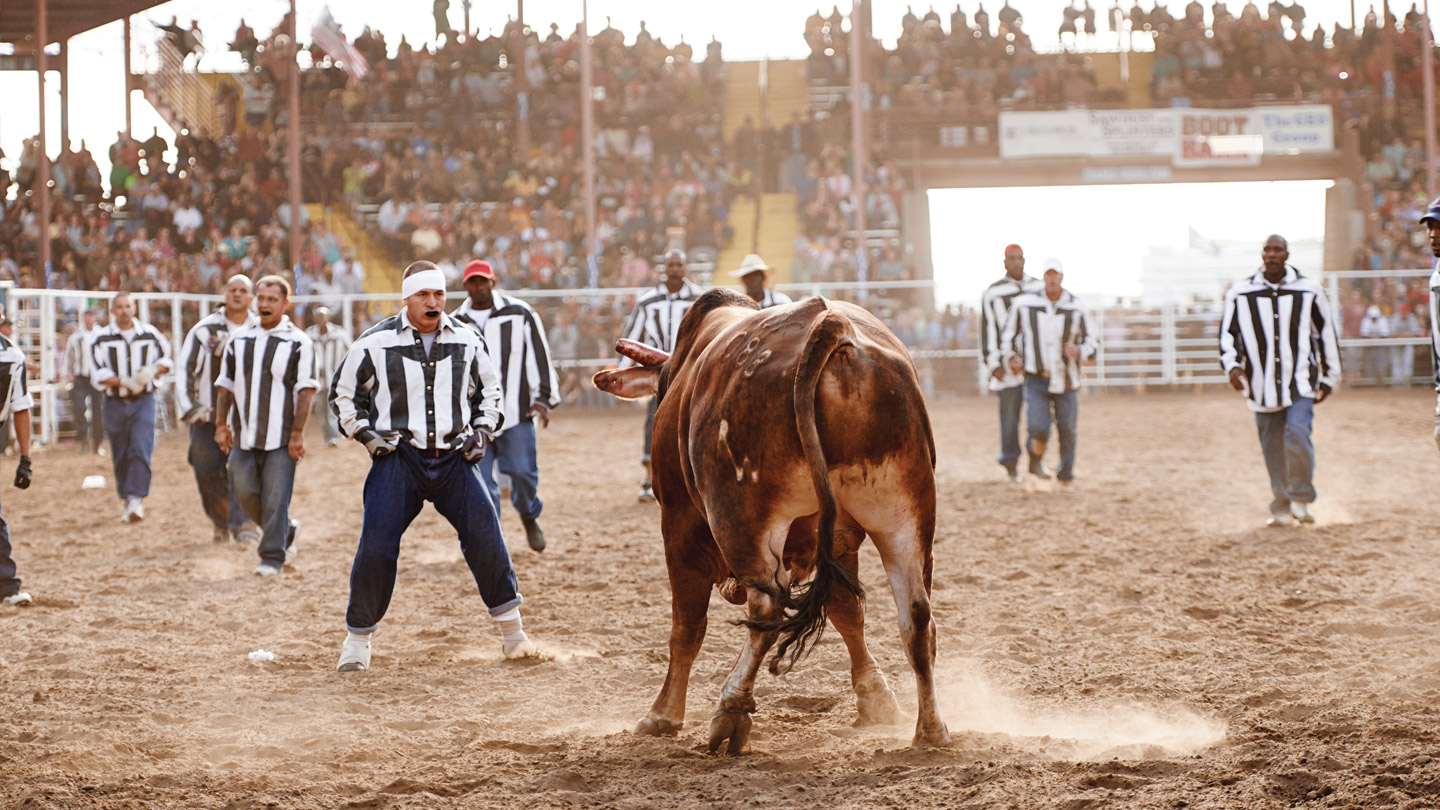His teammates all make fun of his bats. Black, old and worn, with pine tar stains around their necks and blemishes from foul balls dotted all over, they’re certainly not photo-ready; not top-shelf bats, primed for display. But why would they be? They’re tools, not accessories. And when one of those bats is in his hands, you won’t believe what he does with it.
On a mild Michigan night this June, as his Lansing Lugnuts hosted the Dayton Dragons, Vladimir Guerrero Jr. walked confidently to the plate. He carried one of those worked-in bats by the barrel, pausing as he reached the edge of the home plate cutout to carve “Dios” in the dirt. He wiped his hand on the ground and stepped into the box, tapping both the umpire and catcher on the shin to say hello. He dug his cleats into the dirt, setting up in a wide stance and resting the bat on his right shoulder. As the pitcher delivered, he lifted the bat, leaned back on his right leg, and took the most violent cut you’re ever going to see, missing the ball entirely. Next pitch: another violent swing, another strike, as he fouled the ball straight back.

Guerrero went for a little walk, taking his helmet off and running his hand through his amber-tipped dreadlocks before he stepped back in. The deck was stacked against him. You don’t get many good pitches to hit when you’re down 0-2. But Vladimir Guerrero Jr. doesn’t always need a good pitch.
Dayton’s pitcher tried to bury a breaking ball away, but left it up just a little too high — maybe not entirely in the zone, but close enough that Guerrero could get his bat out to the ball. A lot of hitters foul that pitch off. Some ground out or miss entirely. Guerrero put it off the top of the wall in right and cruised easily into second base with a stand-up, opposite-field double.
These are the things that Vladimir Guerrero Jr. does. He’s not just the son of the likely Hall-of-Famer, and he’s more than the phenomenal slugger with an .847 OPS and more walks than strikeouts through his first season and a half of professional ball. He’s the best prospect the Toronto Blue Jays have had in a generation. Baseball America regards him as the second-best prospect in the game, which is saying something considering most people his age just finished the 12th grade. He’s only 18, yet he was recently promoted to high-A Dunedin, where the average player is five years older. He’s yet to reach a level he can’t dominate. He may never. “It’s incredible,” says Blue Jays general manager Ross Atkins. “Everyone who sees him says the exact same thing: ‘He can hit in the major leagues right now.’ You don’t hear that too often about a guy in A-ball. And at his age? You don’t hear that at all.”

Vladimir Guerrero Jr. says he knew he wanted to be a ballplayer from the moment he was born. Perhaps you remember his father, Vladimir Sr., who hit 449 home runs during a 16-year major league career, picking up eight Silver Slugger trophies and an MVP award along the way. And perhaps you’d assume, fairly, that he’d want his son to aspire to do the same. But Guerrero says his father always told him that, though he belonged to a baseball-crazed family, not every Guerrero was going to play the game, and that young Vladimir could pursue any sport he wanted. Guerrero didn’t even consider it. “I was born to do this,” he says through Denis Diaz, the Lugnuts right-hander and proficient translator. He can’t remember a single moment when he thought of doing anything else.
He began playing as soon as he could hold a bat, and by the time he was seven, he was spending every day on a dusty, run-down baseball diamond in Nizao, a remote city of 40,000 on the southern coast of the Dominican Republic. Guerrero’s uncle, Wilton, who played nearly 700 games in the majors for four different teams before retiring in 2005, worked the youngster out every morning while Vlad Sr. played out his career in North America. The daily goal was to take 500 swings between the batting cage, tee and live pitches. Guerrero started at 6 a.m. and wouldn’t go home until he’d reached that number. Often, he’d take batting practice for two hours straight and then go right into fielding groundballs for another hour.
Wilton made some minor tweaks to Guerrero’s swing, sometimes encouraging him to open up more to the pitcher when he was struggling so he could get a better look at the ball. But he generally left the kid’s mechanics alone. At night, Wilton often took his nephew to Summer or Winter League games, where he pointed out the finer aspects of play at that level.
On Saturdays and Sundays, Guerrero played in games of his own — sometimes well-organized, sometimes pick-up. When he was 12, he was already competing against players who were in their early 20s and regularly getting hits against pitchers who threw with high velocity. “I wasn’t nervous. I was just trying to enjoy it,” he says. “It doesn’t matter who I was playing against or how much older they were than me. I was just trying to learn off of them.”

That garnered Guerrero a fair amount of attention at a very young age (some scouts were on him as early as eight years old), and soon, all over the island, people were talking about “Vladdy’s kid,” who swung the bat just like his dad. Of course, Guerrero also spent plenty of time with his father in MLB clubhouses. One of his fondest memories is being on the playing surface at Olympic Stadium for his father’s final game in Montreal. In a child-size uniform, with a batting helmet on his head and sweat bands on each of his wrists, he wasn’t even supposed to be out there, but Expos first baseman Andreas Gallaraga pushed him up and out of the dugout behind his father. When Sr. tipped his cap to the crowd, acknowledging the Expos faithful for a final time, Jr. raised his batting helmet as well.
There are worse players to learn the game from than Vladimir Guerrero Sr., but as Guerrero tells it, his father’s primary guidance was blissfully simple. “The only thing my father ever told me was ‘just watch the ball, and hit the ball.’ That’s it,” he says. “It doesn’t matter where it goes. Watch the ball, hit the ball. Don’t think about anything. Not the swing, not the hands, not anything. Just watch the ball, hit the ball.”
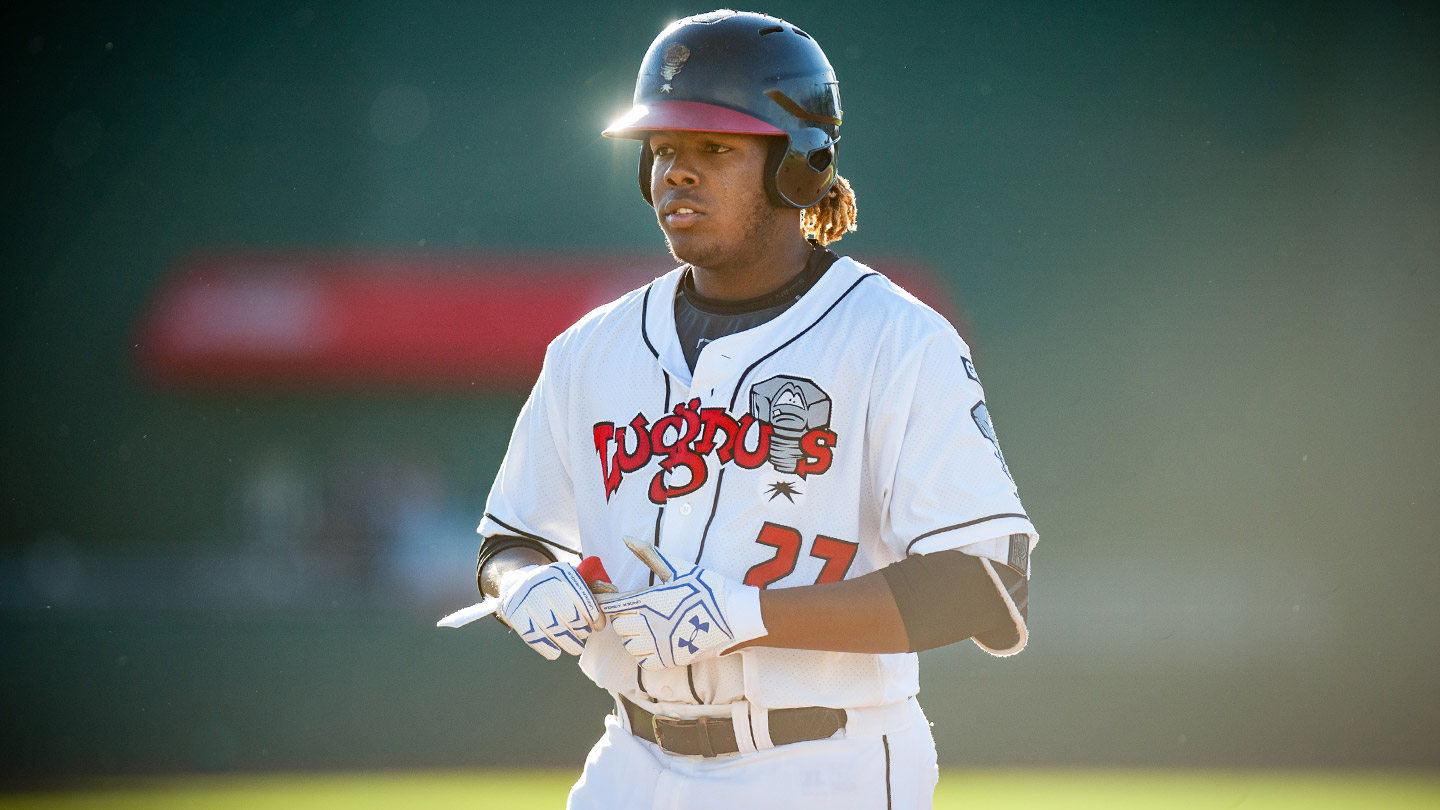
In February 2013, a Blue Jays contingent boarded a plane and made the 3,000-km trip to see the kid everyone was talking about. The group included general manager Alex Anthopoulos, assistant GMs Tony LaCava and Andrew Tinnish, special assistant to the general manager Dana Brown, and scouting director Perry Minasian.
On the ground at the club’s Dominican complex, the group met up with international scouting director Ismael Cruz, a baseball lifer who first saw Guerrero play as a 12-year-old. “It was off the charts. His power was unreal,” Cruz says. “You could tell he was special as soon as you saw him hit. He had more power at that age than any other guy I’ve seen.” Guerrero’s knowledge of the game was equally impressive. Cruz remembers talking to a 14-year-old Guerrero before a game one day, and listening as the teenager predicted how an opposing pitcher was going to attack him. Guerrero said he was going to sit on a breaking ball because he knew the pitcher didn’t want to throw him his fastball. Sure enough, in his first at-bat he got a hanging curveball and hit the seams off of it. “What 14-year-old likes to hit breaking balls?” Cruz asks. “I’m like, ‘You can’t be 14.’ He just has baseball in his blood. He’s beyond his years.”
During that February 2013 workout, Guerrero didn’t disappoint the Blue Jays brass. “Going in, you don’t really know what to expect — he’s just a kid,” LaCava says. “But, really, he was a man. Just the way the ball came off his bat, the way he swung — there was so many natural movements, advanced movements, that are common in major league players. When you see a swing like that, it doesn’t matter how old the kid is, you know it’s something pretty special.”
Anthopolous speaks Spanish and peppered the shy Guerrero with questions in that first visit and every time he saw him over the ensuing months. He asked about the game, family life and how he felt when he didn’t get good grades in school. Guerrero was extremely bashful, but on the third or fourth visit he began to open up. One time, Anthopoulos asked him a simple yet revealing question: What position do you have the most fun playing?
Guerrero was always considered a corner outfielder — that’s where his father played and that’s where his uncle started him when they began training together. But he had a tendency to use an odd arm slot, which all but guaranteed he would never have the outfield cannon his father possessed. That turned a handful of MLB teams off (as did Guerrero’s body composition, which trended more towards husky than athletic). But none of those teams ever asked him the simple question Anthopoulos did, so none of those teams learned Guerrero really wanted to play third base. “When he said that, it was a shock to everybody,” Cruz says. “Even Wilton was like, ‘No, no, no, no, I think he meant outfielder.’ But he said third base. Everybody was like, ‘Really?’ And he goes, ‘Yeah, I like playing there.’”
So, over to third base he went. He wasn’t the fastest fielder, but he had a much stronger arm on the infield, and began throwing from a better arm slot which let him get more muscle behind the ball. The Blue Jays began to dream on how Guerrero’s promising bat would play as a third baseman; how, with proper diet and training, he could slim down and be not only a terrific offensive contributor but a strong defender as well.
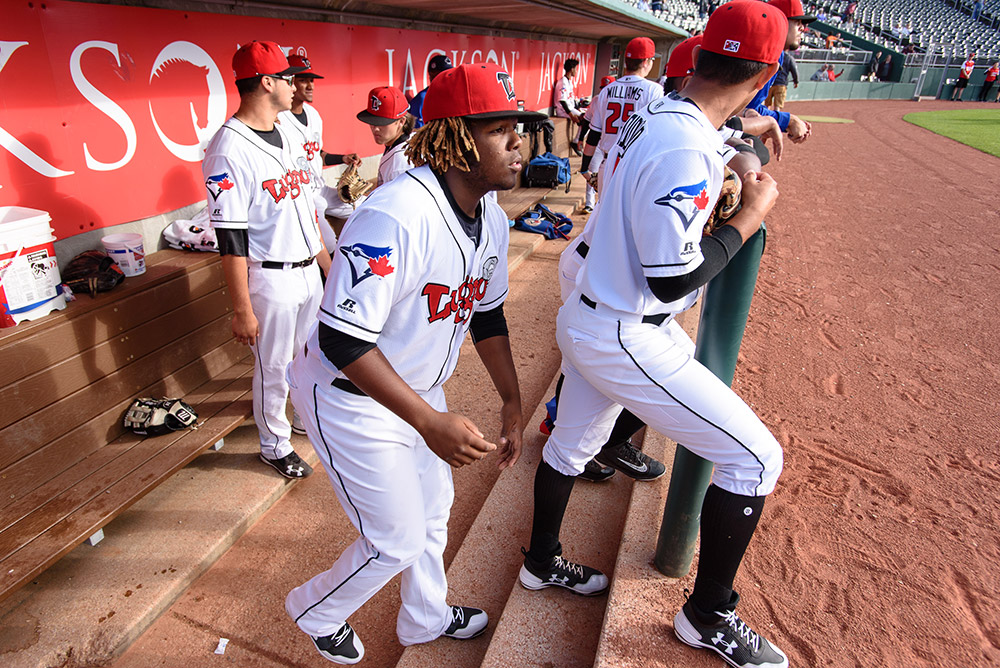
As Guerrero approached 16, Anthopoulos and the Blue Jays started putting the wheels in motion to offer him a contract with a $3.9-million signing bonus, the second-highest the club has ever given out and just a tad higher than the $2,100 bonus his father received from the Expos when he signed in 1993. International free agents aren’t allowed to officially sign until July, but the deal was essentially struck on New Year’s Day in 2015, when Anthopoulos flew to the Dominican Republic, rendezvoused with Cruz, and met with Guerrero and his mother at their home over lunch. “His father wanted Vladdy to be properly recognized for being the son of a big leaguer. And his mother, she was very happy with a Canadian team, because she lived in Canada,” Cruz says. “It came together very smoothly.”
The Blue Jays started Guerrero in rookie ball — with the Appalachian League’s Bluefield Blue Jays — where he hit .271/.359./.449 in 62 games as a 17-year-old. The fact he even played at that level was impressive — most players his age from his part of the world begin in the Dominican Summer League. But Toronto’s front office felt he was advanced enough to get a head start stateside. Guerrero led Bluefield in plate appearances and games played at third base, as the Blue Jays threw the kitchen sink at him. He responded by passing every test. “I’m telling you, he played third base as if he’d been there half his life,” says Dennis Holmberg, who managed Bluefield that year. “He reacted to balls off the bat, he made the slow rollers, he made the backhanded plays down the line. He did everything I could’ve asked.”
Of course, Guerrero’s bat remained his calling card, and what stood out even more than his power at the plate was his patience. He finished his first professional season with only two fewer walks (33) than strikeouts (35), demonstrating near unheard-of plate discipline for a 17-year-old. As Blue Jays evaluators went through Bluefield to see him, they all came back raving about the tough pitches he was able to get his barrel to, or the at-bats where he stubbornly battled a pitcher into throwing him something to hit with two strikes, or the back-foot sliders he was laying off of while his teammates swung right over them.
Guerrero was leaving a strong impression off the field as well. A rookie league coaching staff gets used to dealing with a fair amount of tomfoolery. Holmberg’s way of combating that and teaching his players about professionalism is with a kangaroo court that he calls the Half-Ass Awards, a public honour/shaming for players who are late for the team bus or bring the wrong colour socks on a road trip. Holmberg was very cognizant of involving Guerrero — who was still quite shy and didn’t speak much English — in everything his team did as a group, the Half-Ass Awards included. But no matter how closely he watched his youngest player, he could rarely catch him slipping up. “Vladdy is just an exception to the rule. He’s outstanding. I can’t say enough about this kid. I’ve managed a lot of players. But I don’t know that I’ve ever managed a player so gifted at such a young age,” says Holmberg, who’s been coaching since 1977. “Man, just to try and imagine where he’ll be by the age of 21? I mean, my gosh.”
Tucked away in a corner of a storage area just outside the Lugnuts clubhouse, Carol Walker’s classroom isn’t spacious, but it’s all she needs. On a midweek day in June, Walker is sitting in her chair, behind a long, white desk, waiting patiently for her 12:30 p.m. class to begin. A retired Lansing elementary school teacher, Walker has been working with the Lugnuts for a dozen seasons, helping Latin players pick up English. Some of her students go on to play in the majors; many don’t. None of the players to pass through Walker’s classroom have been as highly touted as one of her pupils today.
At 12:29, Guerrero walks in along with fellow prospect Edward Olivares, a 21-year-old outfielder from Caracas, Venezuela. Guerrero wears a black t-shirt, black shorts, black socks pulled up to his knees, and black sandals. He says hello and asks Walker how she is as he takes his seat, picking up the pen and paper she’s left for him.

Today’s 30-minute lesson will go in many directions. Walker will have Guerrero read recaps of past games, a task he takes particular joy in performing today because he gets to emphasize the second-inning home run Olivares hit the night prior as his embarrassed teammate sits grinning next to him. She’ll have him read weather forecasts for Lansing, Dunedin and Toronto. She’ll show him a map and ask him to read the names of cities and ballparks he’ll be travelling to on upcoming road trips. Finally, as the session is winding down, the class will pick up a book they’ve been working through over several sessions: Michael’s Golden Rules, the Deloris Jordan yarn about baseball and its many ups and downs.
As Guerrero and Olivares take turns reading aloud, players and staff walk by on their way to and from the Lugnuts clubhouse, hardly noticing the English lesson at hand. But one man stops as he passes, grinning as he listens in to Guerrero’s diction. He comes up behind the young third baseman, puts his hands on his shoulders and says something in Spanish that cracks both Guerrero and Olivares up, before going on his way. “Vladdy’s a very special kid,” says Blue Jays legend Carlos Delgado, who now helps the club develop its young prospects as a special assistant to the organization. “He’s just a really nice kid, down to earth, hard-working. You can see why people are raving about him.”
If anyone understands what Guerrero is experiencing right now, it’s Delgado. He was aggressively scouted in Puerto Rico as a 16-year-old, and then ranked the No. 4 prospect in the game by Baseball America in 1992. He went through the same process Guerrero is now, facing the same performance pressures as any homegrown prospect while also encountering imposing challenges off the field as he adapted to a new culture far away from his family. Guerrero admits playing in Bluefield last year was, at times, alienating. “I was all alone by myself for the first time,” he says. “It was very difficult to be away from family. It always is. They’re very important to me.”
This year has been easier. Guerrero’s grandmother, Altagracia, has been living with him, cooking meals for her grandson — just like she did for his father as he made the transition to life in North America decades ago. And those around him say he’s grown more confident on the field and off, taking on a leadership role with the Lugnuts when he was there.
Guerrero certainly has a champion in Walker, who admits to falling in love with the sheepish teenager during their brief time together. “His soft voice, his sweet smile — he’s just a very sweet, kind boy,” she says. “I hope he’s as sweet out there as he is in here with me.” As she comes to the end of her lesson, she reaches into the cubby to her left and pulls out two Halloween-sized chocolate bars, one for each of her students. She asks them to stay safe on their upcoming road trip, play well, and take care of each other. “Thank you, Ms. Walker,” Guerrero says, standing up. “Very good lesson.”

Carlos Delgado had an awfully good career, boasting a major-league CV with 473 home runs and a .929 OPS over more than 2,000 games. He may be one of the most egregious Hall-of-Fame snubs of his era. And he says that when he watches Guerrero play, he sees a kid who’s better prepared for the majors as a teenager than he was.
“It’s kind of scary, isn’t it?” Delgado says. “To see him making adjustments quickly, changing his approach with two strikes — it’s pretty remarkable. This is the stuff that you start talking about with guys later in their careers. Not at 18.”
You’ll hear a lot of similar sentiments from Cesar Martin, Guerrero’s manager in Lansing. In 71 games with the Lugnuts, Guerrero hit .316/.409/.480. He walked six more times than he struck out. He hit three of his seven home runs, and worked 17 of his 40 walks, when he was behind in the count. “I don’t think he realizes how good he is,” Martin says. “At his age, the way he goes about his business — it’s tremendous. You just don’t see it.”

The primary knock against Guerrero is something he can hardly control: He’s only 18, and he does things that 18-year-olds do. Sometimes, during a tedious early afternoon fielding drill, he’ll space out and forget to cover a base or get caught not paying attention as a teammate waits to throw him the ball. Other times, he’ll get annoyed with bad batted-ball luck or hittable pitches he just missed, and carry that frustration into his next plate appearance. If he makes an error at third base early in a game, his coaches can see him thinking about it until the final out. “He’ll make an error and he’ll come back into the dugout very mad. You can see how frustrated he is. I’ll go talk to him and he says, ‘I just want to do everything right,’” Martin says. “And I have to remind him that it’s going to take time. You have to believe in the process. You’re getting better. But everything’s step-by-step. You have to understand that.”
The Blue Jays would like to eliminate the times he carries that frustration through the rest of a game. He’s still a Guerrero, after all, which means there’s no pitch you can throw him that he doesn’t think he can hit. And on the nights when he’s letting his emotions get the better of him, he has a tendency to try to make up for his mistakes with his bat, abandoning his approach and swinging for the fences no matter what the pitcher throws. Sometimes it works, because Guerrero has uncommon power and can hit pitches most players can’t. But expanding the zone and getting over-aggressive aren’t tendencies that will aid productivity as he reaches more advanced levels. “Vlad does get himself out sometimes. He’ll go that extra mile and try to hit the ball too far,” says Lansing hitting coach Donny Murphy. “And he really doesn’t have to. His approach works when he sticks with it. It’s a maturity thing, really. We forget he’s a kid. He’s supposed to be in high school. You know, at his age, sometimes you’re wanting to show everybody how much you’ve got.”
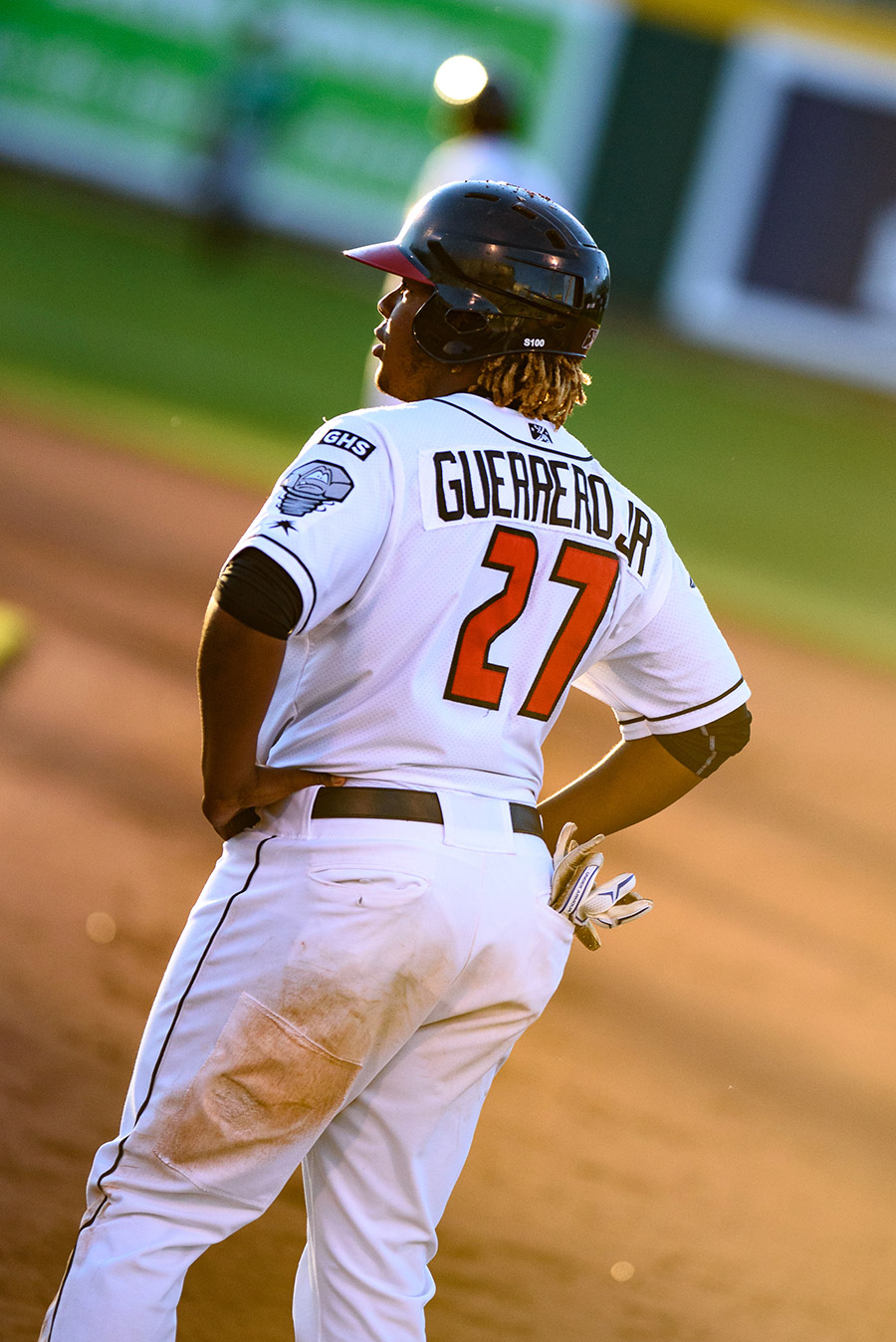
The Blue Jays are confident in Guerrero’s ability to learn from his mistakes, believing that as he ages and faces more game situations he’ll smooth out his self-defeating tendencies and get over failure quicker. When Guerrero was in Lansing, he had conversations with Martin three to four times a week about his performance, how he was feeling mentally and physically, how pitchers were attacking him, and how he was going about things on and off the field. Martin’s the first Latin manager Guerrero’s had in the Blue Jays organization, and it’s likely no coincidence that his three months in Lansing coincided with his biggest steps forward from a mental standpoint. By the time Guerrero moved on to Dunedin, he had a clear understanding of what’s been limiting him, and what he needs to do to have success at the next level. “I know one at-bat can make me overthink the next,” he says. “If you play baseball, at some point you’re going to fail. You’ve just got to deal with it, work with it, and know that baseball always gives you an opportunity for revenge. The next day you play again.”
How long it takes Guerrero to grow out of some of his adolescent habits could be the answer to the question on everyone’s mind: when will we see him in the majors? Ask around and you’ll find plenty of people who will tell you Guerrero’s bat is big-league ready. It’s only the areas around the margins that need work. “If you put him in a major-league game today, he’d get hits, no question,” says Cruz. “He’s special. I think he could be ready before he’s 20.”
Cruz remembers Guerrero telling him when he was 15 that he wanted to be in the big leagues within three years. He also remembers Guerrero doubling down on that pledge a year later, telling reporters during a visit to Rogers Centre shortly after he signed that he wanted to be in the majors within two.
Well, it’s been two. And Guerrero’s only just been promoted to high-A, which is still aggressive, especially for a Blue Jays front office that tends to opt for the cautious approach with its prospects. Regardless, on his current track, with a double-A promotion a distinct possibility in 2018, when he’ll be only 19, it’s not hard to imagine Guerrero reaching the majors at 20. “We’ll see,” Atkins says. “There’s a lot more to it than just OPS. Our thought process is always to put him in the best environment to succeed and be challenged.”
Asked this June if he had a new timeline in mind, Guerrero chose to be broad rather than specific, while still making it clear he’s not interested in waiting around. “The only thing in my mind is just to get to the big leagues as quickly as possible,” he says. “Who knows when that will be? But I’m trying to make everything happen as quickly as I can.”
All we know is that day is coming. The one when Guerrero steps to the plate for the first time in Toronto, realizing everything he’s worked towards as he carves “Dios” in the dirt with one of those old, worn, black bats in his hand. Just a kid watching the ball, and hitting the ball.


